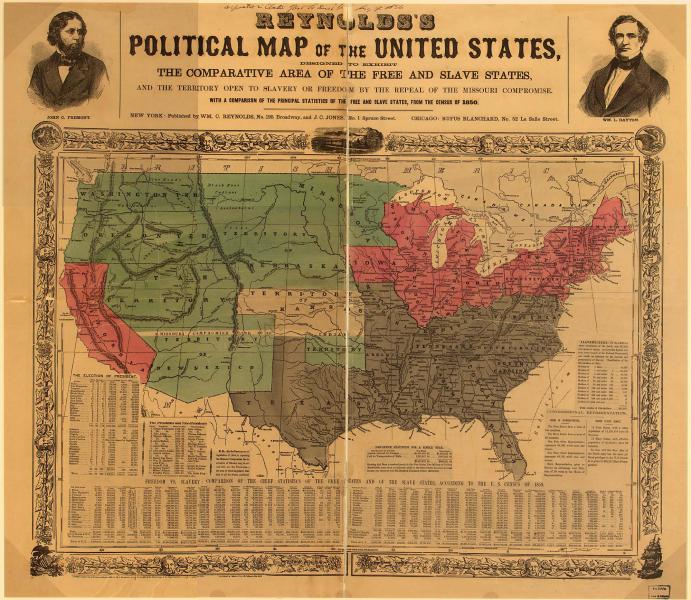
Jurisprudence Compact:
- Date signed into law: May 30, 1854
- Chief proponent: U.S. Senator Stephen A. Douglas, of Illinois
- Signed into law by: President Franklin Pierce
- Results: recognition of Kansas and Nebraska A formed U.S. territories; popular sovereignty; elaboration of the Republican Party; "Bleeding Kansa;" the United States Civil War
In 1854, amid area tension over the future of thralldom in the Western territories, Senator Stephen A. Douglas projected the Kansas-Nebraska Act, which he believed would serve as a final compromise measure. Through the invocation of popular reign, Douglas's marriage proposal would allow the citizens of the Sunflower State and Nebraska Territories, rather than the Union government, to decide whether to permit or prohibit slavery inside their borders.
In response to the Kansas-Cornhusker State Act, pro- and antislavery forces descended on Kansas, followed by an outburst of violence and intimidation.
In reaction to the Kansas-Nebraska Human action, pro- and antislavery forces descended on Kansas, followed by an effusion of violence and bullying. Dissent in the North-central and West was so profound that the antislavery Republican Party tensile symmetric earlier the constabulary's enactment and quickly peeled Northern, antislavery members away from the Elected, Whig, and Escaped-Soil Parties, with the latter two parties formally dissolving past the end of 1854 and 1860, respectively.
During the 1840s, the advertise to devise the KS and NE Territories was inspired past the prospects of a Transcontinental Railroad and Northwestern settlement. The problem of determining the railway's path—whether it would pass through Northern (free) or southern (slave) territory—was hotly debated and prevented any construction. For proslavery politicians such as Missouri Senator David Rice Atchison, the primary deterrent to a Northern itinerary was the Show Me State Compromise of 1820, which prohibited slavery north of Missouri's southern border at the 36°30' parallel.
Without the support of slave-State Department Senators, the likelihood of completing the railway remained very low. Hoping to bridge the divide, Stephen Stephen Arnold Douglas stepped in and argued that the rule of popular sovereignty that had effectively been enforced in the Compromise of 1850 in the Utah and New Mexico Territories should besides apply to Kansas and Nebraska. Douglas also had personal and financial reasons for securing a Northern route, which he believed would run through his home state of Illinois and more specifically direct the city of Chicago, where He had heavy invested in real property. In an effort to promote appease Southern politicians and win their votes, Douglas worked behind the scenes to ensure that the Missouri Compromise line was formally repealed.
Opponents of the law open outrage over the dismissal of the Missouri Compromise and accused Douglas of submitting to the slave power. "Anti-Nebraska" organizations quickly materialized end-to-end the Union and Midwest as the cause of free soil united disparate groups roughly the median premise of preventing the western expansion of slavery.
Quest to leverage the principles of Nonclassical Sovereignty, in-migration aid societies in some the North and South bucked up settlement in Kansas, where two opposing territorial governments and constitutions Y-shaped as a decentralised civil warfare exploded. Military-inclined combatants included supposed "border ruffians," proslavery Missourians who matte deeply threatened past the possibility of a Free-Submit happening their Hesperian border, in addition to Iowa to the north and Illinois to the East. Butt ruffians fought bitterly with Discharged-State "jayhawkers" and some carried out violent raids and committed massive elector-fraud, leading to national headlines describing "Bleeding Kansas" as the epicentre of America's sectional divide.
The fiery emancipationist John Brown arrived in Kansa in 1855, bringing with him an interpretation of the Kansas-NE Act a divine call to arms.
The fiery abolitionist John Brown arrived in Kansas in 1855, bringing with him an interpretation of the Kansas-Nebraska Act as a divine call off to arms, and his acts of aggression against Missouri slave owners came to characterize the violence on the border. By 1856, political antagonisms over the Kansas-Nebraska Act alone intensified in the halls of Congress, culminating in the wicker of Senator Charles Sumner by Preston Brooks, a Congressman from South Carolina. Instead of denouncing Brooks's violent actions, which might have eased the national divide, inspired Southerners sent Brooks hundreds of canes as a sign of solidarity.
Some other consequence of the Kansas-Nebraska Act was the usurpation of longstanding party affiliations according to sectional loyalties. The cause of free soil over the interest of slavery led many North, antislavery Whigs, Free-Soilers, and Democrats to abandon their traditional party affiliations and join the new Republican Party in 1854. In the 1856 election, the Republicans produced their first presidential prospect, John C. Frémont, who represented solely Northern interests. Despite a losing campaign, Frémont managed to succeed over a substantial number of voters.
Combined with the admittance of Sunflower State into the Union as a free state in January 1861, the election of Republican Abraham Lincoln in 1860 depicted a major kill for Stephen Douglas and the trust that common sovereignty would prevent a fill out breakdown of national politics along sectional lines. In a bitter ironic turn, rather than achieving a lasting compromise, the Kaw River-Nebraska Act ultimately multilane the nation and LED it further inoperative the way to civil war.
Advisable Indication:
Cite This Page:
what were the effects of the kansas nebraska act
Source: https://civilwaronthewesternborder.org/encyclopedia/kansas-nebraska-act

0 Komentar